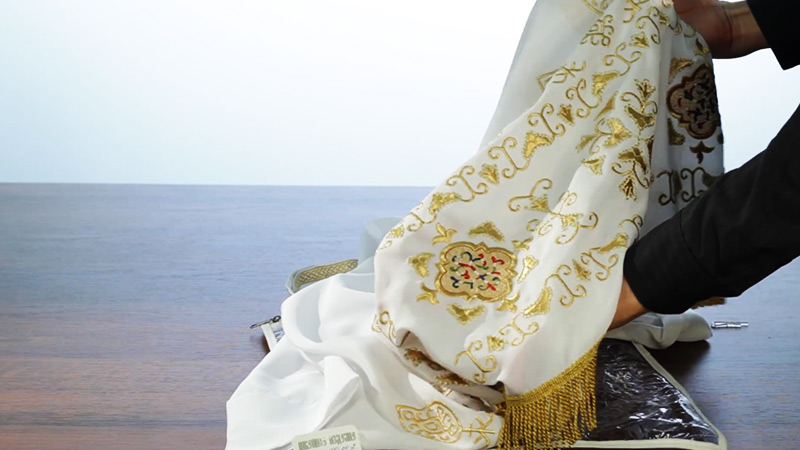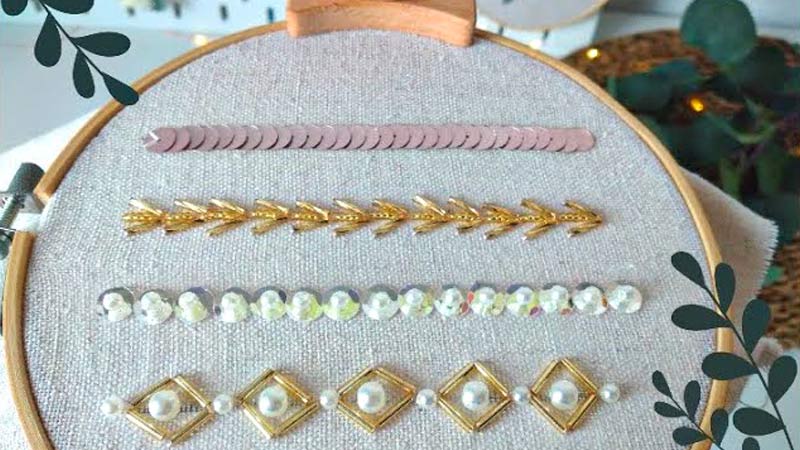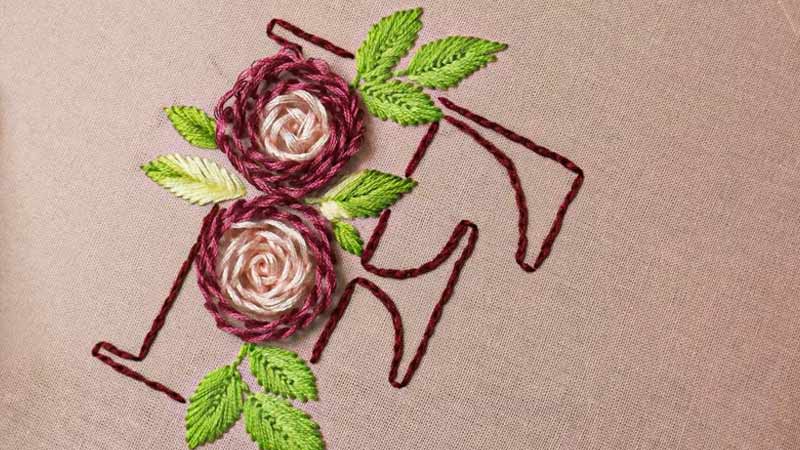Convent embroidery weaves a tapestry of tradition, craftsmanship, and spiritual dedication. Rooted in the sacred surroundings of convents, this art form encompasses the meticulous needlework often undertaken by nuns.
From adorning ecclesiastical garments with intricate stitches to embodying meditative simplicity, convent embroidery reflects a fusion of creativity and devotion.
This intricate craft has historical significance, preserving the artistic contributions of women within religious communities.
In exploring “What Is Convent Embroidery,” we unravel the threads that bind together heritage, faith, and the delicate artistry that transcends time.

What Is Convent?
A convent is a communal residence for a group of individuals, typically women, who have dedicated their lives to religious contemplation, prayer, and service.
In a convent, members often live a structured and communal life under the guidance of a religious order or community.
These communities can vary in size and may follow different religious traditions within Christianity. Convents are places where individuals, known as nuns or sisters, commit to a life of religious vows, such as poverty, chastity, and obedience.
The purpose of a convent extends beyond residence; it serves as a center for spiritual reflection and worship and often includes facilities for education, healthcare, or charitable activities aligned with the religious principles of the community.
What Is Convent Embroidery?
Delving into the multifaceted world of convent embroidery, this term holds several meanings, each contributing to a rich understanding of its significance.
Exploring seven dimensions of this craft sheds light on its historical, cultural, and artistic contexts.
Traditional Ecclesiastical Embroidery
Convent embroidery often refers to the intricate needlework done by nuns in convents. Traditionally, this includes exquisite ecclesiastical pieces used to adorn religious garments, altar cloths, or other sacred items.
Simple and Meditative Stitches
The term can also encompass simple and meditative stitches practiced in convents. These uncomplicated stitches reflect a meditative and contemplative approach, creating pieces with a serene and timeless quality.
Cultural Heritage
Convent embroidery contributes to the cultural heritage of regions where convents have played a vital role. The styles, techniques, and motifs often reflect the community’s specific cultural and artistic influences.
Historical Significance

Convent embroidery holds historical significance, preserving the craftsmanship of nuns throughout the centuries. It provides a glimpse into the artistic contributions of women within religious communities.
Educational Endeavors
Some convents engage in educational embroidery projects, passing down skills and techniques from generation to generation. This form of convent work ensures the continuation of traditional embroidery knowledge.
Social and Economic Impact
Convent embroidery has sometimes served as a source of economic support for convents. Through the creation and sale of embroidered items, convents contribute to their sustenance and charitable endeavors.
Contemporary Expressions
In modern contexts, convent embroidery can take on contemporary expressions, adapting traditional techniques to new artistic visions. This adaptive quality ensures the relevance and evolution of the craft.
Understanding convent embroidery requires appreciating its diverse meanings, ranging from its historical roots to contemporary adaptations.
This multifaceted craft showcases the resilience, creativity, and cultural contributions of convent communities throughout history.
Types Of Convents
As religious communities, convents have existed for centuries, each with its unique focus and purpose. Exploring the diverse types of convents provides insight into how these communities contribute to spiritual, educational, and charitable endeavors.
Contemplative Convents
Contemplative convents emphasize a life of prayer, solitude, and spiritual contemplation. Nuns in these communities dedicate themselves to a monastic lifestyle, focusing on deepening their connection with the divine through contemplative practices.
Educational Convents

Educational convents prioritize teaching and nurturing intellectual development. Nuns in these convents often run schools, colleges, or other educational institutions, providing a foundation of knowledge and fostering holistic growth in their students.
Medical and Healthcare Convents
Some convents specialize in medical and healthcare services, operating hospitals, clinics, or providing nursing care. Nuns in these communities contribute to the well-being of individuals by offering medical assistance and compassionate care.
Missionary Convents
Missionary convents are dedicated to outreach and service beyond their immediate communities. Nuns in these convents engage in missionary work, traveling to different regions to provide humanitarian aid, education, and spiritual guidance.
Charitable Convents
Charitable convents focus on various forms of social service and charitable activities. Nuns in these communities may run orphanages and shelters or engage in initiatives to support the marginalized and disadvantaged.
Clerical Convents
Clerical convents may be associated with specific religious orders or congregations. Nuns in these convents serve in clerical roles within the church, contributing to liturgical activities, pastoral care, and administrative duties.
Artistic and Creative Convents
Some convents have a distinct focus on artistic and creative pursuits, including convents known for their embroidery, manuscript illumination, or other forms of artistic expression.
Nuns in these communities channel their creativity in ways that enrich both the religious and artistic realms.
Understanding the types of convents showcases the diversity of roles and contributions these communities make, reflecting a collective commitment to spiritual values and service across various domains.
Convent Embroidery Sarees Pattern
Embracing the timeless charm of petit point embroidery sarees, these exquisite patterns add a touch of sophistication to traditional attire.
Let’s explore seven enchanting designs that showcase the intricate beauty of petit point embroidery on sarees.
Floral Elegance

Petits points delicately form intricate floral motifs across the saree, creating a garden of timeless beauty. The fine stitches capture the essence of nature, offering an ethereal and graceful appeal.
Paisley Paradise
The paisley pattern takes center stage in petit point embroidery, weaving a tapestry of intricate swirls and curves. Adorning the saree, these paisley motifs add a regal and artistic flair to the ensemble.
Peacock Splendor
Petit point embroidery brings peacocks to life on sarees, with each stitch capturing the majestic feathers and intricate details. The vibrant hues and meticulous craftsmanship celebrate the elegance of this revered bird.
Vine and Leaf Accents
Sarees adorned with petite vines and leaves showcase the versatility of petit point embroidery. The delicate stitches form a cascade of foliage, imparting a sense of organic beauty and subtle charm.
Classic Geometric Precision
Achieving geometric perfection, petit point embroidery creates precise patterns on sarees. Whether it’s squares, diamonds, or intricate patterns, the precision of these geometric designs adds a modern touch to traditional attire.
Mughal-inspired Motifs
Drawing inspiration from Mughal art, petit point embroidery on sarees features intricate motifs reminiscent of the regal Mughal era. These patterns showcase a blend of history, art, and cultural richness.
Temple Border Grandeur
Petit point embroidery graces the borders of sarees with temple-inspired designs. Elaborate motifs reminiscent of temple architecture create a grand and majestic look, adding a divine touch to the ensemble.
Incorporating petit point embroidery into saree patterns elevates the traditional garment, infusing it with a fusion of artistry and cultural richness.
Each pattern tells a story, making these sarees not just attire but exquisite canvases of craftsmanship and elegance.
FAQs
What types of garments feature convent embroidery?
Convent embroidery is commonly found on ecclesiastical garments, including robes, altar cloths, and sacred vestments. However, its versatility extends to various textiles, contributing to both religious and artistic expressions.
How does convent embroidery differ from other forms of embroidery?
Convent embroidery often incorporates meditative stitches and reflects a sense of devotion and simplicity. It stands apart through its connection to religious life, emphasizing both spiritual and artistic dimensions.
Can anyone learn convent embroidery?
While traditionally associated with nuns, anyone interested in the craft can learn convent embroidery techniques. Many convents offer workshops or share their expertise to preserve and pass down this unique form of needlework.
Does convent embroidery have contemporary applications?
Yes, convent embroidery has evolved to include contemporary expressions. Artists and crafters draw inspiration from convent embroidery, adapting traditional techniques to create modern pieces that honor the heritage while embracing new artistic visions.
Conclusion
Convent embroidery is a testament to the enduring legacy of craftsmanship within religious communities.
Whether adorning sacred garments or expressing artistic prowess through meditative stitches, convent embroidery encapsulates the essence of devotion and creativity.
Its historical roots, cultural contributions, and contemporary expressions showcase a craft that extends beyond mere needlework.
Convent embroidery holds historical significance as it preserves the artistic contributions of women within religious communities. It reflects a blend of faith, tradition, and craftsmanship, showcasing the dedication of nuns to both spiritual and creative pursuits.
As we appreciate the intricate beauty spun by the hands of devoted individuals within convents, we recognize that convent embroidery is not just an art form but a tangible manifestation of spirituality, tradition, and the enduring spirit of creativity.
Leave a Reply